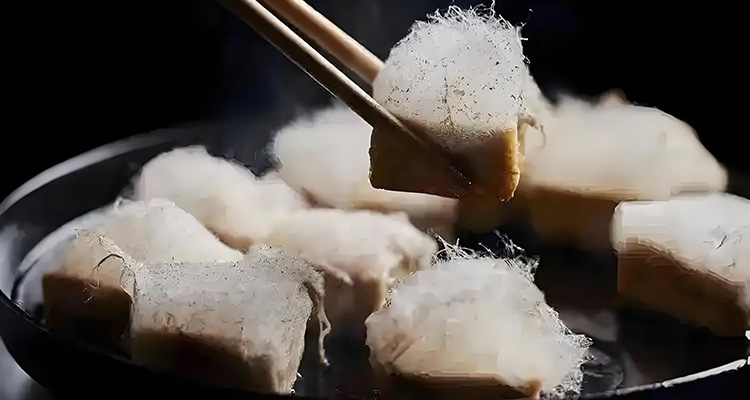Discover Mao Tofu (Fuzzy Tofu): Huizhou’s Fermented Snack
Imagine strolling along the stone lanes of Huizhou with the warm, appetizing scent of freshly fried Mao tofu in the air. This fermented soybean curd, covered in a soft white fuzz, has been a regional specialty around Huangshan for centuries. With a crisp golden crust and a tender, creamy interior carrying a subtle fermented aroma, Mao tofu is a must-try Huizhou street snack that tells the story of local foodcraft and history.
1.Origin and History: A Southern Song Invention
Mao tofu dates back to the Southern Song era and originated in old Huizhou (today’s Huangshan, Anhui). Traders needed a way to preserve tofu on long journeys. They discovered that inoculating tofu with certain molds and allowing it to ferment extended its shelf life and created a new flavor. These traveling merchants refined the method—cutting fresh tofu into small pieces and encouraging white mold growth—giving the snack its name: Mao (meaning ‘hair’ or ‘fuzz’) tofu. Over eight hundred years, it evolved from a traveler’s ration into a beloved regional delicacy.
2.Cultural Significance: A Living Street-Food Tradition
In Huizhou, Mao tofu is more than food; it’s a cultural emblem. Street vendors carrying oil pans and bamboo baskets on shoulder poles, frying and selling Mao tofu on the spot, form a familiar local scene. The snack appears at festivals and family gatherings and symbolizes local ingenuity and heritage. For residents, eating Mao tofu reconnects them to home and shared memories.

3.Ingredients: Simple Tofu and Beneficial Mold
The main ingredient is firm fresh tofu made from high-quality soybeans. The key is the mold, typically species of Mucor, which is applied to the tofu surface under controlled temperature and humidity. The mold produces white mycelium and breaks down proteins into flavorful amino acids, creating that distinct fermented aroma—natural and additive-free.
4.How It’s Made: From Tofu Block to Fuzzy Delight
Making Mao tofu is a careful, artisanal process. Fresh tofu is cut into 3–5 cm pieces, inoculated with the mold, and placed on bamboo trays or racks in a cool, humid environment (about 15–20°C) for 2–3 days. A dense white fuzz forms across the surface, indicating successful fermentation. Skilled makers monitor temperature and hygiene to avoid over-fermentation. The final step is deep-frying until the exterior turns golden and crisp.

5.Taste and Texture: Crispy Outside, Creamy Inside
Once fried, Mao tofu delivers contrasting textures: a crunchy golden exterior and a silky, soft center. The flavor is subtly complex—mildly tangy, slightly sweet, and pleasantly savory—often compared to mild cheese or natto but gentler. Fermentation adds depth and umami, while the frying process intensifies aroma and mouthfeel. It’s rich in easily absorbed proteins and beneficial microbes.
6.How to Eat It: Street Style and Sauces
The most authentic way to enjoy Mao tofu is freshly fried from a street vendor. Typically served with a dipping sauce—spicy chili paste mixed with garlic, soy, and sesame oil—this combination brightens the fermented notes. Sweet bean sauce or broad-bean chili paste are other local options. Eat it hot on a bamboo skewer for the full sensory experience.
fermented tofu
7.Tasting Tips: Best Time and Pairings
For peak flavor, eat Mao tofu immediately after it’s fried. Pair it with a cup of Huangshan Maofeng tea or local rice wine to cut the oiliness and refresh the palate. Spring and autumn offer the most pleasant street-food atmosphere in Huizhou. A typical portion has 4–6 pieces—perfect for sharing—and costs around 10–20 RMB.
8.Where to Try and Buy: Tourist Recommendations
Top spots to sample Mao tofu include Tunxi Old Street (Huangshan City), Shexian Ancient Town, and the villages near Hongcun and Xidi. Look for long-established stalls or restaurants advertising traditional Huizhou flavors. When buying, choose tofu with an even white fuzz and no discoloration. You can buy pre-fermented (unfried) Mao tofu to take home—keep it refrigerated and eat soon after frying.
9.Home Version: A Simple DIY Guide
If you can’t visit Huizhou, try a home experiment. Use firm tofu, a Mucor starter (available online or in specialty stores), and a clean bamboo or wire rack. Blanch tofu briefly, cool, dust with starter, and incubate at about 18–20°C under a damp cloth for 2–3 days until white fuzz appears. Fry or pan-sear until golden. Home results won’t fully match traditional methods but offer a fun introduction to Chinese fermentation.


